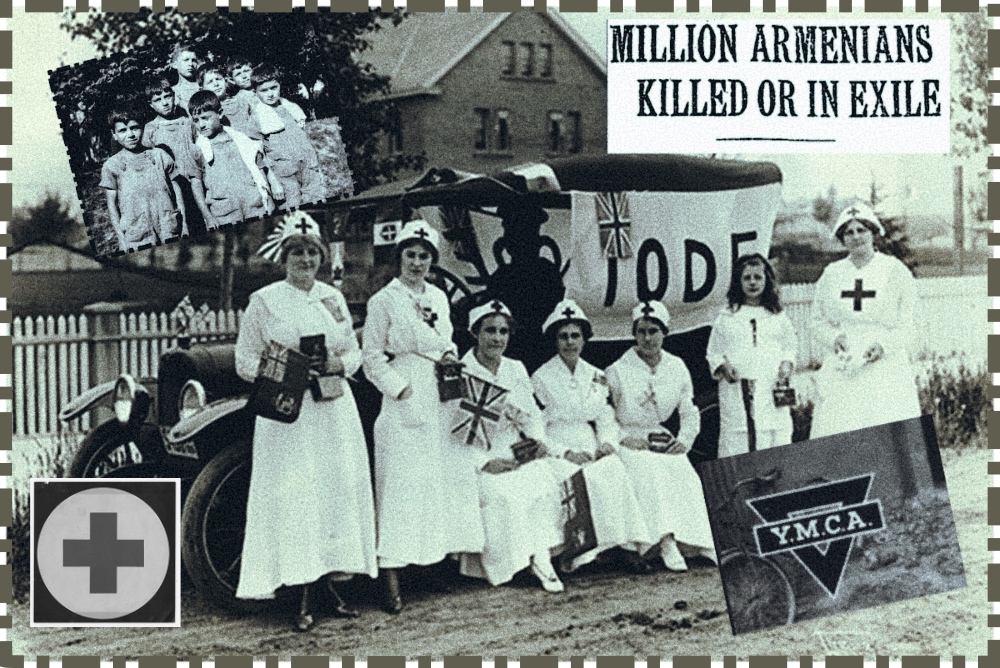Humanity in Wartime
Canada’s Aid for Armenian Genocide Survivors
Exhibit E: Canada’s Response
Canada’s response to the Armenian Genocide (1915–1923) was rooted in compassion, solidarity, and action. Through the efforts of ordinary citizens, church networks, civic organizations, and pioneering humanitarian leaders, Canadians mobilized medical aid, raised public awareness, and helped resettle survivors of one of the twentieth century’s greatest humanitarian crises. Canada played a globally significant role by offering refuge, relief, and long-term support to Armenian Genocide orphans through landmark efforts like the Georgetown Boys program.
A Nation Responds: Civil Society and the Churches
Women’s Missionary Networks and Relief Drives
Canadian Presbyterian and Methodist women led one of the most organized and impactful responses. Women’s auxiliaries and church boards—many tied to the Women’s Missionary Society of the Presbyterian Church—organized national fundraisers, clothing drives, and medical supply shipments to the Near East.
Local congregations sponsored entire rooms in orphanages or hospital wards. Letters from Canadian missionaries like Isabel Trask, who documented the suffering of Armenian families and children, were reprinted in church bulletins and helped galvanize support. These appeals, grounded in a strong sense of humanitarian duty, brought Canadians together to aid a people in crisis.
Canadian Press Coverage and Public Awareness
Throughout the First World War, Canadian newspapers carried regular reports on the atrocities committed against Armenians. Major publications such as the Toronto Star, The Globe, and Montreal Gazette printed stories detailing massacres, starvation, and deportations—often citing relief organizations and missionaries on the ground.
Public campaigns like Golden Rule Sunday encouraged families to eat modestly for one meal and donate their savings to Armenian relief efforts. This grassroots generosity extended across the country, with churches and women’s organizations raising substantial support for aid initiatives in Armenia, Syria, and Greece.
The Georgetown Boys: Canada as a Refuge
The First Government-Supported Refugee Resettlement Program for Children
In 1923, Canada became the first country in the world to implement a refugee resettlement program specifically for Armenian Genocide orphans. Organized by the Armenian Relief Association of Canada and supported by provincial authorities in Ontario, the initiative brought 50 Armenian boys to Cedarvale Farm in Georgetown, Ontario.
Program Highlights:
- The farm served as both a home and agricultural training center.
- The boys, most of whom were genocide survivors, were taught English, farming techniques, and skilled trades.
- Between 1923 and 1927, 110 boys arrived in total.
- In 1927, a smaller group of Armenian girls was also welcomed, marking Canada’s first gender-inclusive refugee sponsorship program.
Cultural Legacy:
- The boys published a bilingual newsletter, Ararat, in Armenian and English.
- Many settled in cities such as Toronto, Hamilton, and Montreal, helping form the foundation of Canada’s Armenian communities.
- In 2010, Cedarvale Park was designated a provincial heritage site to honour this effort.
Notable Canadians Who Advocated or Aided
Sara Corning (Nova Scotia)
Sara Corning’s contributions are a central part of Canada’s humanitarian legacy. A nurse from Nova Scotia, she participated in Near East Relief efforts and played a heroic role in rescuing over 5,000 orphans in Smyrna in 1922. She later managed orphanages in Greece and supported the educational development of Armenian children. Her legacy is commemorated by a statue in Yarmouth and the Sara Corning Centre for Genocide Education in Toronto.
Rev. Dr. J.C. Webster (New Brunswick)
Dr. John Clarence Webster, a physician, historian, and Canadian Senator, was an early advocate for Armenian relief. In 1920, he actively encouraged donations and supported humanitarian campaigns aimed at aiding survivors. His leadership reflected a broader Canadian commitment to global justice.
Rev. James Endicott (Toronto)
As a Methodist minister and later moderator of the United Church of Canada, Rev. James Endicott was a strong voice for Armenian humanitarian aid. His sermons and writings highlighted the plight of Armenians and called for sustained Canadian engagement well into the 1930s.
Long-Term Impact on Canadian Humanitarian Policy
The Georgetown Boys program became a model for future Canadian refugee resettlement efforts. It demonstrated the power of private sponsorship, civic engagement, and compassion in shaping effective humanitarian policy. The legacy of Canada’s early response contributed directly to the evolution of the country’s global leadership in refugee protection and human rights.
From Relief to Legacy
Canada’s response to the Armenian Genocide was a story of compassion in action. From church basements to rural farms, Canadians came together to support a people in need. The contributions of nurses like Sara Corning, missionaries like Isabel Trask, and community organizations across the country helped deliver tangible relief and lasting hope.
This humanitarian legacy lives on in the descendants of the Georgetown Boys, in the vibrant Armenian-Canadian communities they helped found, and in Canada’s continued commitment to standing with those facing persecution. The Armenian Genocide, though distant in geography, found a powerful response in Canada’s people—and left an enduring mark on its humanitarian identity.
“In their care, We found hope.”
The Armenian Genocide Museum of Canada honours the women, nurses, men, and organizations across Canada who mobilized aid, raised awareness, and helped rescue Armenian orphans during and after the Genocide.

